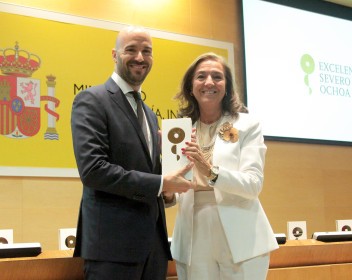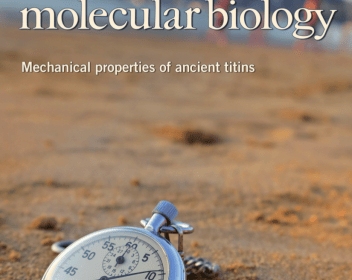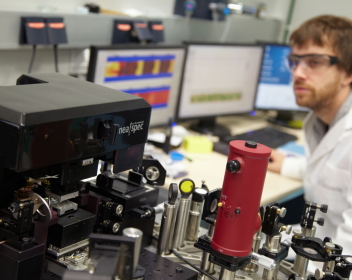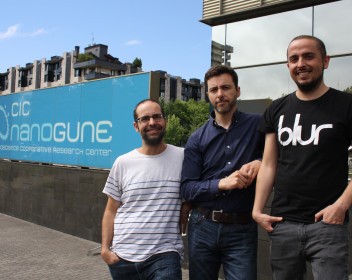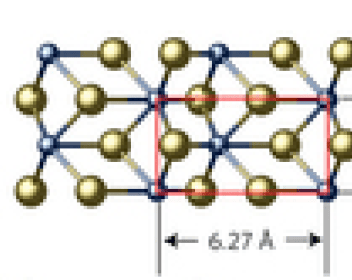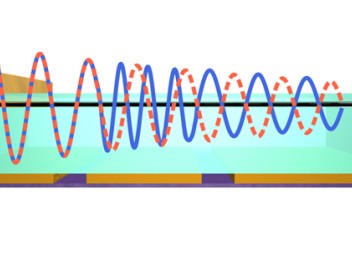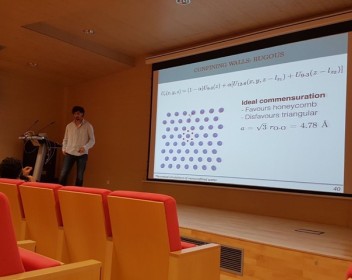Newsroom
News
nanoGUNE recives the María de Maeztu distinction
Ikerbasque Professor Luis Hueso, accompanied by the Director General of nanoGUNE, José M. Pitarke, has collected the distinction Maria de Maeztu for research excellence on behalf of the Basque research center in nanoscience. This distinction will bring nanoGUNE a financial envelope of 500,000 euros per year for four years.
2017 Magnetism Roadmap
With the co-authorship of nanoGUNE’s Nanomagnetism group leaders Dr. Andreas Berger and Dr. Paolo Vavassori, the Journal of Physics D – Applied Physics just published the 2017 Magnetism Roadmap. As a whole, the 2017 Magnetism Roadmap, which is an Open Access article, is intended to act as a reference point and guideline for emerging research directions in modern magnetism.
San Sebastian to the NSMB cover
Electronic tailoring of graphene nanostructures via on-surface synthesis
Eduard Carbonell, Pre-doctoral Researcher at the nanoimaging Group at CIC nanoGUNE, received his PhD at the University of the Basque Country (UPV/EHU) after the defense of his thesis project on 28 July 2017. His research work, entitled “Electronic tailoring of graphene nanostructures via on-surface synthesis", has been developed under the supervision of Dr. José Ignacio Pascual, nanoimaging group leader.
Infrared nanospectroscopy and hyperspectral nanoimaging of organic matter
Iban Amenabar, Pre-doctoral Researcher at the Nanooptics Group at CIC nanoGUNE, received his PhD at the University of the Basque Country (UPV/EHU) after the defense of his thesis project on 12 July 2017. His research work, entitled “ Infrared nanospectroscopy and hyperspectral nanoimaging of organic matter", has been developed under the supervision of Dr. Rainer Hillenbrand, Nanootpics group leader.
The size of animals dating back 100-350 million years ago inferred from resurrected proteins
The prestigious journal Nature Structural & Molecular Biology has published a piece of research conducted by CIC nanoGUNE researchers. They have experimentally reconstructed titin fragments from their common ancestors and measured their mechanochemical properties. They have discovered a correlation between the properties of the protein measured on a nanoscale and animal size.
Future materials are becoming 'topological’
A tremendously thin layer of wolfram and tellurium has turned out to be an exotic type of material that physicists have dubbed a ‘topological insulator’. NanoGUNE has participated in the study published in Nature Physics. The physical properties of this two-dimensional material confers it a promising future in the emerging field of spintronics.
Ultra-compact phase modulators based on graphene plasmons
The City Hall of San Sebastian and nanoGUNE sign an agreement to support technology-based companies and entrepreneurs
Theoretical Simulations of Nanoconfined Water
Jon Zubeltzu, Pre-doctoral Researcher at the Theory Group at CIC nanoGUNE, received his PhD at the University of the Basque Country (UPV/EHU) after the defense of his thesis project on 5 June 2017. His research work, entitled “Theoretical Simulations of Nanoconfined Water", has been developed under the supervision of Prof. Emilio Artacho, Theory group leader.
Agenda
| Mon | Tue | Wed | Thu | Fri | Sat | Sun |
|---|---|---|---|---|---|---|
|
29
|
30
|
31
|
1
|
2
|
3
|
4
|
|
|
|
|
|
|
|
|
|
5
|
6
|
7
|
8
|
9
|
10
|
11
|
|
|
|
|
|
|
|
|
|
12
|
13
|
14
|
15
|
16
|
17
|
18
|
|
|
|
|
|
|
|
|
|
19
|
20
|
21
|
24
|
25
|
||
|
|
|
|
|
|
||
|
30
|
31
|
1
|
||||
|
|
|
|
Events
- 29/01/2026
Frontiers in Quantum Electronics
- 04/02/2026 to 06/02/2026
nanoGUNE Winter School 2026
nanoVISUALS
Find events' photos, experimental images, videos, audios, and nanoGUNE's corporate images.

